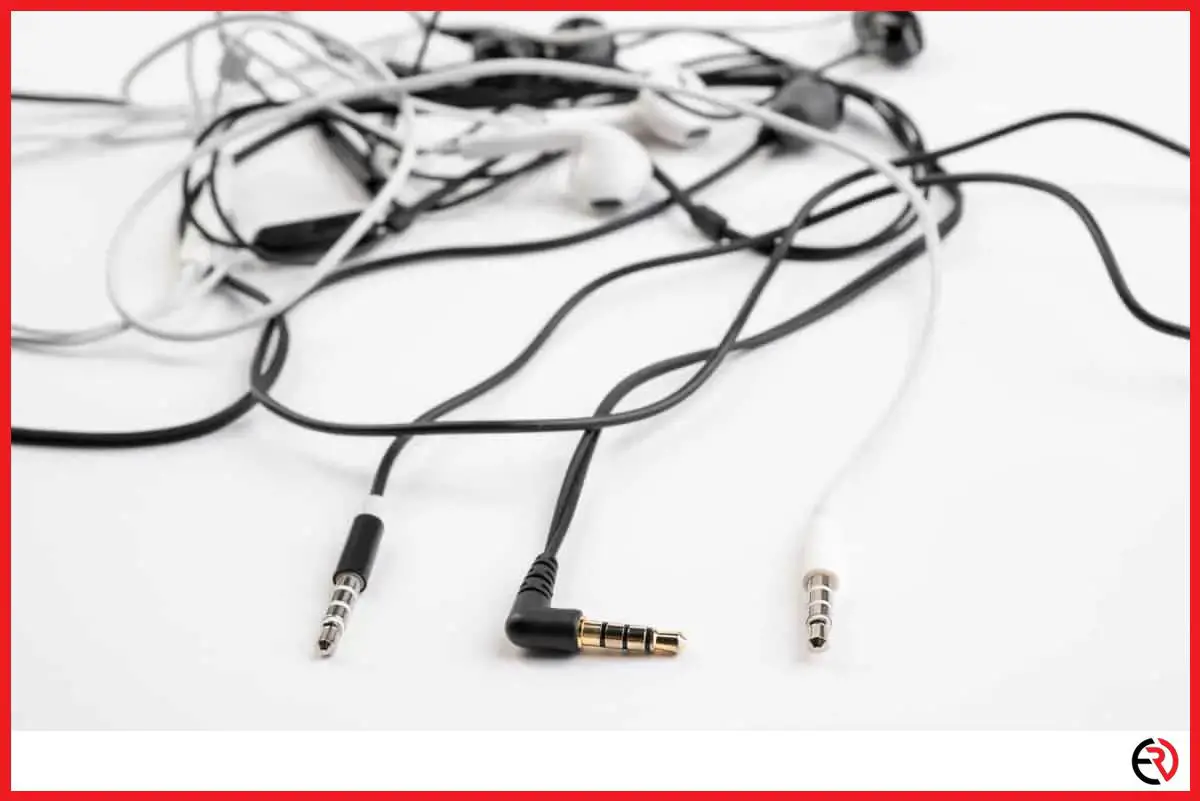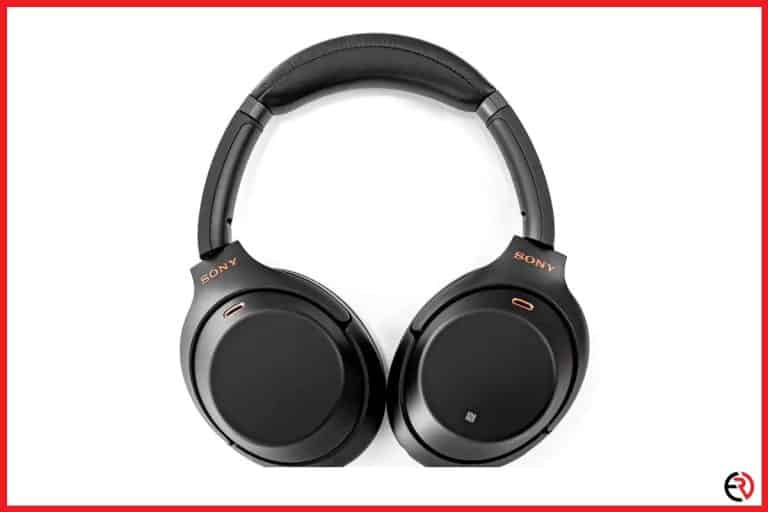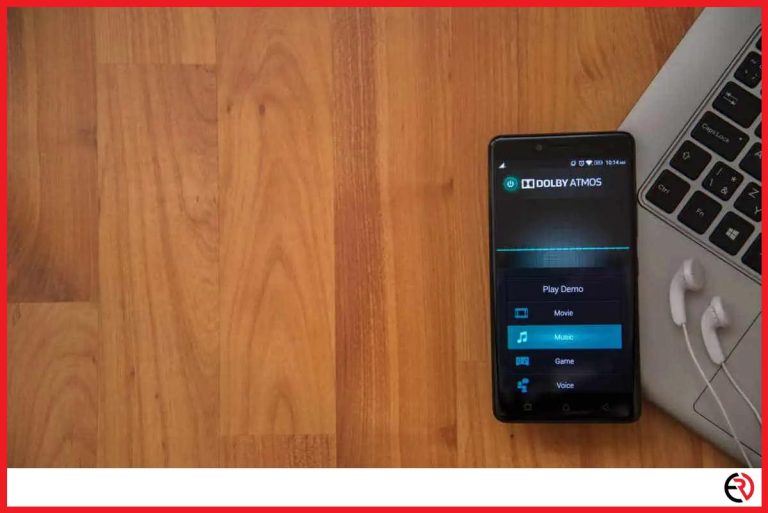How do Tangle-Free Headphones Work?
This post may contain affiliate links which means that, if you choose to make a purchase, I may earn a small commission at no extra cost to you.
We’ve all suffered the problem of tangled headphone wires. Aside from purchasing an expensive set of Bluetooth headphones, there are tangle-free headphones on the market which might make your experience with wires better and get you back to your music or podcast faster.
How do tangle-free headphones work? There are a few approaches to get tangle-free headphones. Flat cables, mesh designs, rigid exterior covers, and zipper headphones all have design elements intended to discourage tangling of the wires.
Not only do these headphones help with tangled messes, but they look great and are cost-effective. It can help defeat the small hinderance of cords when you’re on the go between classes or flights.
Tangle-Free Headphones
Tangle-free headphones can ease the annoyance of pulling tangled headphones from your bag or pack. They come in a few different shapes and styles, so you can find a pair that matches you. these headphones can be found for the same price as normal headphones. The different types of tangle-free headphones which you can buy are:
- Flat Cables
- Mesh Designs
- Exterior Covers
- Zipper Headphones
You’ve probably seen others with the flat cord for headphones.
The design of the flat cable isn’t just for looks; the flatness is an attempt to keep the wires stiffer so that they don’t curl together. Also, when the flat cables are in a confined space, when they push against the walls of their container, the flat edge provides more surface area to hold to the sides. This means fewer tangles.
Some headphones come with a thin mesh wiring around the cable.
This cable design also aims to keep the cables stiffer and less likely to wrap together. If you take a cable with the mesh coating and try to rub the two wires together, you’ll find that the tiny intricate mesh has a much harder time trying to roll together.
There are headphones sold with a rigid exterior casing.
A few of these headphones come with the tangle-resistant barrier, or they can be purchased and used on your current headphones. They simply slide over the cords like a protective shield. These come in many styles and are easily packed away.
Zipper headphones are good at avoiding tangles.
A zipper headphone does exactly as its name implies, they zip up like a zipper. When the cords are zipped together, they become stronger together, and the two earpiece ends don’t wrap around one another. Zipper headphones come in different colors and different sizes and are sure to help you with a tangling issue.
Do Tangle-Free Headphones Sound Different?
There are no noticeable sound quality differences between headphones with flat or regular cables, so you don’t have to worry about your music being affected. Since these headphones are far less likely to tangle, they’ll receive less damage than regular cords and won’t require replacement as often. You can find a great list of tangle-free headphones here.
Pros and Cons of Going Tangle-Free
No one likes snarled up cords. But there are some specific instances when having a tangle-free option really helps out.
- If you’re a gamer, then you won’t be short of finding a pair of tangle-free headsets that will give you the same gaming experience without the chance of wrapped cords.
- Musicians and producers might want to consider a pair of tangle-free headphones too since they work amongst a bunch of other cords and cables.
- Even at your desk, if your hands are busy typing in front of you, the last thing you need is your headphone cords twisted together while you’re trying to work.
Disadvantages to Tangle-Free Headphones
With the cables of tangle-free headphones being so stiff, it can make it a little difficult to properly store your headphones. Some flat cords can be folded, but the design will try its best to open back up. This makes these headphones feel a little bulkier in pockets or might take more room in your pack than a regular set of cables.
Why Do Headphones Knot?
It’s frustrating to find that your efforts to place your headphones away neatly didn’t work, as you pull the twisted knots from their hiding spot. Why do headphones knot, even when they’re tucked in nice and tight?
Headphones knot because motion causes the cables to roll and if two cables are up against one another, then they will roll into each other. There is a field of mathematics that studies the reasons behind knotting. Tests have shown that keeping headphones in a confined container with stiff walls works well.
If the headphone cables are pressed against the rigid wall, then they are less likely to roll. If the cords are unconfined and they are rubbed together, then they will curl into each other and cause knots or tangles. Tangle-free headphones attempt to keep the cables stiffer to slow down the tangles.
Worst Place for Your Headphones (Where Most Tangles Happen)
There are a few places where your headphones are almost guaranteed to bunch up on you. Be wary of putting your headphones in your pocket.
Sliding your headphones into your pocket is the easiest way to store a small pair of headphones, especially when you’re in a rush, but the motion from walking is almost a sure thing to start twisting those wires together.
When the headphones are in your pocket, it’s equivalent to having the cords in between your palms while rubbing them together. There’s a lot of potential for twisting and knots. Not to mention, when you pull your headphones from your pockets and start untangling, it can cause tension and damage to the wires.
The Mathematics of Knots
Tame and wild knots are the two different types of knots that can occur. Within those two types, there are more.
- A tame knot is a polygonal knot, with a finite number of double points. It’s an orderly know.
- A wild knot is random and sporadic.
- Two or more knots are referred to as a link.
- If divided into in-depth, there have been 120 different types of knots labeled in knot theory.
Knot theory can really tangle up your brain. The bottom line is that all of those knots can affect your headphones.
If you want to learn more about the mathematics of knots, here’s some fodder. And tangle theory is also heavily based on mathematics. Here’s more info about that.
The lesson is this: tangling is inevitable if nothing is done to try and prevent it.
DIY Tangle-Free Headphones
If you’re looking for a quick fix before you can get your hands on a pair of tangle-free headphones, then there are some DIY approaches that can help you.
Some of these things may be sitting around your house, but you may need to pick up a cheap piece or two for your craft. This is great for people that like to customize their headphones or carriers. Here are the DIY tricks:
- Embroidery Floss
- Cases
- Binder Clip
- Clothes Pins
- Wrap them around something
Embroidery floss is a string used for sewing or needlework. It’s incredibly cheap, and if you have a sewing machine nearby, then you may already have some on hand. The floss is tied around the cables to make them thicker and more resistant to bending.
To wrap the floss around, it’s best to use a tying technique known as the Chinese staircase. This also adds the phone aspect of being able to customize the look of your headphones since you can get embroidery floss in several colors. For a step by step, guide, check this out.
Another great way to keep your headphones tangle-free is to use a small container. If you can’t make yourself a small box or container, then check to see if you have any empty pill bottles, because those make a great holder since they’re hard plastic and headphones can be tightly squeezed into them. Mint containers such as Altoids or TicTacs boxes work exceptionally well.
Those big binder clips and more useful than just holding documents together. With a binder clip, you can neatly wrap your headphones and use the clip to hold them tight. These are compact enough to fit neatly into your bag. Careful not to wrap the cords around the clip too tightly.
You can use clothespins to hold your headphone cables together. Superglue the clothespins together with the heads facing opposite directions. All you need to do after that is wrap with headphones around the clothespins and clamp them into place.
Wrap your headphones around something, anything, to keep them from tangling. If you carefully wrap your headphones around something in your bag, rather than just dropping them in there, you’ll be fine. It’s when those cords are just free-floating that they find their way into knots.
People are always looking for new and easy methods to keep their headphones from wrapping together. You can stay up to date with these trends too.
Are Your Headphones Already Twisted Together?
If you’re currently struggling with twisted headphones, try these:
- Unplug from the source
- Work from the bottom
- Pull the cord through knots
When you find that your headphone wires are tangled, you’ll want to unplug it from any device. Trying to untangle your headphone wires while they’re still plugged in will cause you more headaches.
When you begin to untangle your cords, start from the bottom where the headphones insert into a device. It’s much easier to unwrap the cords with a single point.
Slowly pull the cord through any knots. If the cords give you any resistance, you can use the jack to wedge the knot-free and separate them. Don’t put too much strain on the cords so you can avoid damage.
Remember to always pull the cords through gently so you don’t tear any of the coatings or damage any of the wires.
The Ultimate Tangle-Free: Cord-Free
Although tangle-free headphones work far better than regular ones, you still might run into a situation of a knot. The only true way to 100% avoids tangle-free headphones is to use cordless headphones.
Though it’s great to avoid a tangled mess for certain, there are a few downsides to Bluetooth headphones:
- The cost of wireless or Bluetooth headphones is much higher than your standard tangle-free or regular headphones.
- If you’re using Bluetooth earbuds, there is a greater risk that one will get separated from the other, so it’s essential to have a container for them.
- Wireless headphones tend to have lower sound quality than that of wired headphones
- You have to keep wireless headphones charged, something you never have to worry about with a wire.
- Sound quality suffers from a distance with wireless. If a wireless headset is too far away from the device it’s connected to, then the sound can cut in and out or eventually disconnect.
Cordless headphones are rarely used by music producers because they need to have the best quality of sound which they can achieve and the corded headphones, even compared to high-end wireless, have superior sound.
Still, if a tangled up mess is your largest concern, there are too many cordless options out there to count.
- There are simple, affordable options for under $20 available online and in stores. The only wire on these is the one that connects the two earpieces together. This wire commonly goes behind your head, so it’s out of the way.
Those affordable options are great for times you really don’t want any cords getting in your way, such as working out or mowing the lawn. You’re not going to worry if they get sweaty or fall into the grass for $20.
- There are high-quality, high-prices options, too. Sets like this one cost closer to $200. These higher-end headphones are known for exceptional clarity, longer range and have the benefit of also being able to use them wired. With the thicker, rounded-cord cables that tend not to tangle!
These aren’t the kind of headphones you’re likely to use at the gym or in the yard unless you don’t mind the wear and tear on a pricier piece of equipment.
Other Corded Headphone and Earbud Issues
Tangled wires aren’t the only pain that can come with using your headphones. Some other common issues with headphones are:
- Dirt
- Exposed Wires
- Hearing Damage
- Static Sound
- Assisted Voices
With a pair of over-ear headphones, it’s not as much of an issue, but earbuds should be cleaned regularly. Dirt and earwax can easily get stuck in the tiny holes in earbuds. These can be cleaned by using toothpicks to clean out any clogs and a disinfecting wipe. There is more in-depth cleaning information here.
A common sign of wear on your headphones is exposed wires. More times than not, the exposures happen near the jack or the headphone earpieces. These can be fixed with electrical tape, but it may also be a sign that it’s time for a new pair of headphones.
Earbuds can cause hearing damage. If you listen to earbuds too loud, it can cause damage to your earbuds. This problem isn’t as common with bigger headphones. The louder the music, the higher the strain on your eardrums. The earbuds cause damage since they are inserted so far into the ear.
Some headphones cause a static noise. If your hearing a static noise in your headphones, then the first step is to check and make sure the jack is plugged all the way in. If that’s not the problem, then you might have a faulty jack or aux port.
“Smart assistant” Interference. If you’re listening to your headphones through your phone or a device that has a personal assistant such as Siri, then you notice your music cuts off when the assistant is speaking. On some occasions, the personal assistant can come out louder than the audio you were previously listening to.
When It’s Time to Replace
As mentioned above, if you can’t rid your headphones of the static noise, then it might be time to get a new pair. You might need to get a replacement when your headphones start distorting music at higher volumes or one side or both begin to cut out.
You may also want to consider replacing your headphones if you’re still using those free white ones which Apple gave you with an iPhone. They aren’t the greatest. But they work well in a pinch or if you need pairs in multiple locations.
How Often Do Headphones Need to Be Replaced?
If you treat your headphones gently, then you can get 3 or more years of use from them. On average, a pair of headphones last 1 to 3 years. If you’re using the tangle-free headphones, then you’ll more than likely see the longer side of that, since you’ll have less tugging and pulling on the cords to set them free.
Other Special Headphones
If you’re looking for something unique, try:
- Single-Sided
- Bone-Conducted Headphones
- Sleepphones
- Noise Reduction Headphones
- Auditory Impaired Headphones
A new design in the headphone world is single-sided headphones. These may seem a little strange at first sight, but they are great for laying down with. They can be used when lounging or sleeping. They’re not ideal for music since we like to hear our tunes in stereo. But they work for practical applications, like phone calls.
Price: Single-sided headphones are very reasonably priced. You’d have to look pretty hard to find one over $25.
Bone-conducted headphones are headphones that don’t go in your ear; they transmit the sound through your skull to your eardrum. This is a perfect innovation for people who want to listen to their headphones while still being able to hear the outside world. This is becoming the leading technology used for military personnel so they can stay in contact while still being aware of their surroundings.
Price: Bone-conducted headphones are on the higher-end of tech. And you’ll pay for it. Expect the range to be between $50 and $150 for an average set.
Sleep Headphones are a band with headphone pieces inserted inside of them. They look like workout bands and can be used as such too. They are great for sleeping because they won’t fall off your head when tossing and turning in your sleep.
These headphones are incredibly comfortable to help with falling asleep to music or audio sound. Some of the designs of sleep headphones are also great for exercise so that your headphones will stay comfortably on your head during quick movements or when you’re running.
Price: The average cost for a pair of sleep headphones ranges from $25 to $100, depending on the brand, quality, and fabric.
There are several headphones on the market now, which are noise reduction. This means that the headphones cut out all the sound around them. These headphones are great for anyone that is trying to cut out the outside sounds such as gamers and musicians.
Price: Noise reduction or cancellation headphones can get pricey. Expect them to start around $50 and go up into the hundreds of dollars. The sound quality, brand, and other perks are what make the price difference.
Several headphones have been designed to help people that have an auditory impairment and for people with special needs. These headphones are made with these challenges in mind. Some children and adults with special needs find it necessary and comforting to use headphones in many social settings, loud areas or unfamiliar situations, such as:
- Airports
- Airplanes
- Concerts
- Sports arenas
- Noisy public places
- Areas where there is a lot of conversation
- Large areas that echo
- Shopping Malls
If you know someone who can benefit from headphones like these or from noise-reducing earmuffs, you can search this great list for ideas.
Headphone Safety
Headphone cords can cause other issues, like tangling up your hands when you’re wearing them and trying to engage in an activity. Keep that in mind when you are using your corded headphones. Use extra care – or skip corded headphones altogether when you’re working with anything hot, sharp or fragile.
In fact, while engaging in some activities, it’s just not the right time or place to use any headphones – corded or cordless.
- Driving a car or other motor vehicle. In many states, wearing any headphones while driving is illegal. The exception in some states seems to be a one-ear headphone or earbud designed for hands-free use of a phone.
- Riding a bicycle in traffic. While it’s unlikely that you’ll find that this is illegal too many places (though Quebec, Canada is one such city), is it the best idea to ride alongside cars on your bike without being fully aware of your surroundings? If you must, please consider a one-ear headset so you can enjoy your tunes or podcast, but also hear what’s happening on the street.
- Swimming in the pool. Use caution. Not because the battery in cordless headphones is enough to cause you harm, but because you can easily wreck your headphones if they get submerged.
Kids and Headphones
Little ears can occasionally borrow your headphones, but you’re better off getting your kids a set of their own. There are lots of options that have a great sound and protect the more fragile ears of little ones.
In fact, even the design of the headphones can make a difference in how a set affects your child’s hearing. An article in New York magazine outlined some of the best options for kids, with consultation from pediatric experts and hearing specialists.
The verdict was that kids should stick to the over-the-ear type of headphones that also have a “volume limiter that reduces exposure to excessively loud noises.” This was recommended above anything else, including any of earbuds that call their designs “safe for kids.”
Whether or not kids have cords on their headphones doesn’t seem to be too much of a worry. It all depends on what activity your child is engaging in while listening. If they’re running around and dancing, you may want to go with cordless. If they’re just hanging out, listening to music or a book, corded headphones do the job.
But we all know how well kids and tangles seem to go together, so try to look for a tangle-free design!
The Conclusion About Tangle-Free Cables
While the tangle-free design is, fortunately, something that is available, much of what will keep your headphones from tangling is how you treat them and care for them. Toss them in your bag or pocket without much thought, and you’ll probably end up with some snarly cords.
If you take care when you transport or store your headphones, odds of winding up with tangled-up cores are going to be much less.
The good news about the designs used for tangle-free cords like the ones found on headphones is that these tactics are being used for all different types of cables now. Phone chargers, ethernet cables, HDMI, and others can be just as bad about ending up in knots. So, the more devices and cords we have, the nicer it is to see manufacturers thinking about tangle-free options.
This is all to ensure that you don’t run into the issue of tangled cords and to save the longevity of all your cables. We are getting closer and closer to a day without tangles, perhaps the cords will become even more resistant to it, or wireless options will improve giving the same quality as the wired option.







